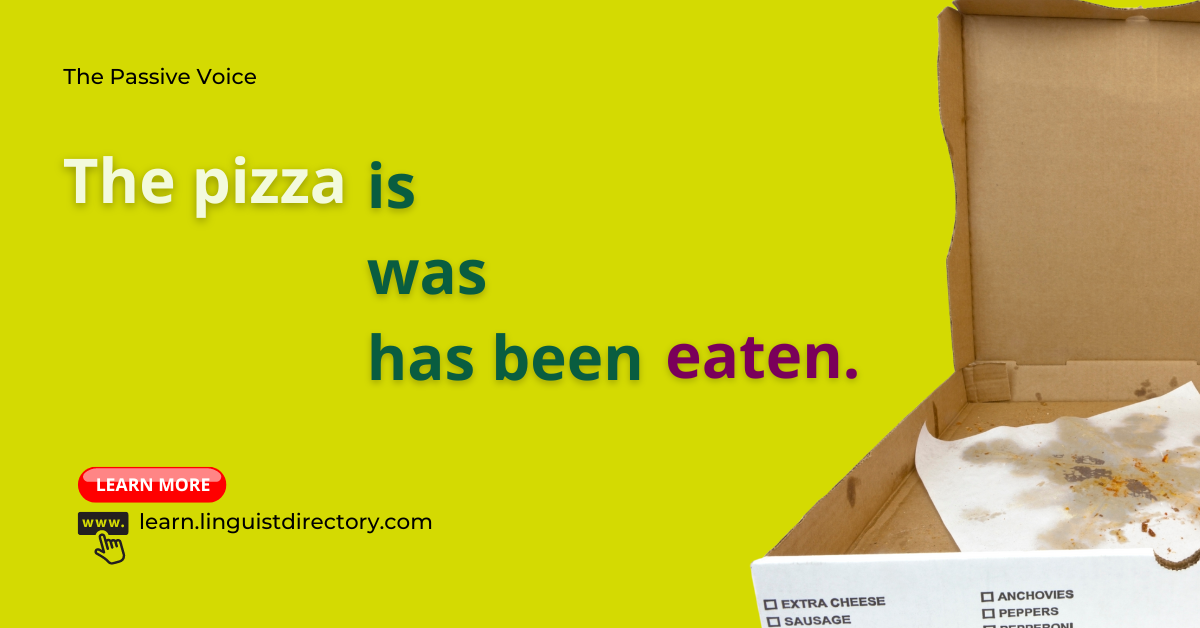
The passive voice
The passive voice is used when we want to focus on the person or thing affected by the action and not the performer of the action.
Active: ❌I ate two biscuits. (the focus is on me – the performer of the action)
Passive: ✅Two biscuits were eaten by me. (the focus is on the biscuits – the thing affected by the action)
Active: Subject is first (the person or thing that causes the action), followed by the verb, and finally the object (the person or thing affected by the action).
❌I – ate – two biscuits. ‘I’ is the subject, the verb is ‘ate’ and the object is ‘two biscuits’
Passive: Object is first (the thing affected by the action), followed by the verb, and finally the subject (the person or thing that causes the action).
✅Two biscuits – were eaten – by me.
How to make the passive in English
To make the passive put the verb ‘to be’ into the tense you need and add the past participle.
the object > the verb ‘to be’ in the tense we need > the past participle
- Regular verbs – make the past participle by adding ‘ed’ to the infinitive. E.g. bake > baked, clean > cleaned.
- Irregular verbs (click for the list of irregular verbs)
We use the passive voice:
- 1️⃣ to change the focus of the sentence,
✅The Sistine Chapel ceiling was painted by Michelangelo. (The main focus is on the painting, not the artist.)
- 2️⃣ when the causes of the action (who or what) are unknown, unimportant, obvious or ‘people’ in general,
✅He was arrested (obvious agent, the police).
✅Your car has been serviced (unknown agent).
✅High street shops are being closed (unimportant agent).
✅Your child can be collected from the school (people in general).
- 3️⃣ in formal, factual or scientific writing,
✅The data was uploaded to a hard drive.
✅Your appointment has been rescheduled.
✅The article was written by artificial intelligence.
✅The investigation is being conducted by our office.
- 4️⃣ In order to put new/ less important information at the end (to improve style),
✅These new books are currently used in the class. The books were purchased by the City Council.
| Tense | Active | Passive |
|---|---|---|
| Present Simple | I eat a biscuit. | A biscuit is eaten (by me). |
| Present Continuous | I am eating a biscuit. | A biscuit is being eaten (by me). |
| Past Simple | I ate a biscuit. | A biscuit was eaten (by me). |
| Past Continuous | I was eating a biscuit. | A biscuit was being eaten (by me). |
| Present Perfect | I have eaten a biscuit. | A biscuit has been eaten (by me). |
| Present Perfect Continuous | I have been eating a biscuit. | A biscuit has been being eaten (by me). |
| Past Perfect | I had eaten a biscuit. | A biscuit had been eaten (by me). |
| Future Simple | I will eat a biscuit. | A biscuit will be eaten (by me). |
| Future Perfect | I will have eaten a biscuit. | A biscuit will have been eaten (by me). |
